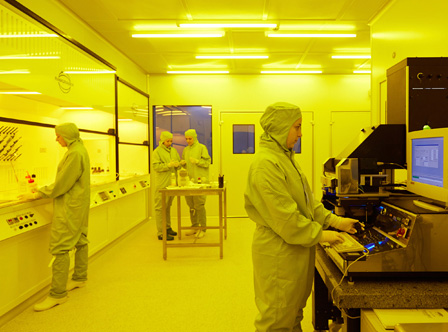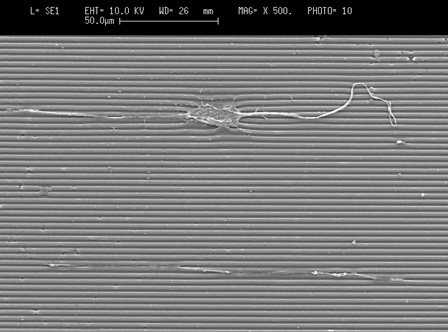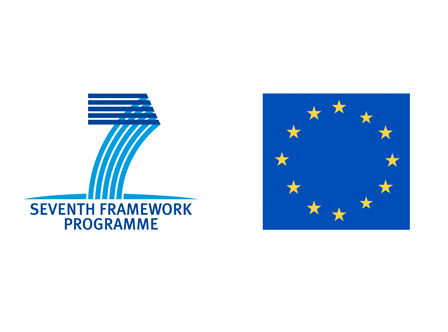PROJECTS



It will enable new prostheses designed to replace autologous implants currently used in this condition to be developed, and will allow more severe nerve severing to be successfully addressed.
Damage to the peripheral nervous system, usually caused by serious accidents, can lead to loss of motor control and sensory perception. The consequence of this type of injury has a severe impact on the quality of life of thousands of people of all ages. Peripheral nerve injuries are responsible for over a million medical consultations every year in the USA and Europe, of which over 10% end up in the operating theatre. The physical impairments resulting from this injury are caused by the lack of connections between the nerve cells owing to the severing of the nerve.
Due to the seriousness of this condition and its widespread occurrence, the combination of science and technology is endeavouring to find new means for clearing the path towards technology capable of reversing its consequences. So the aim here is to manufacture implants using biocompatible and biodegradable materials and to develop micromanufacturing technologies to generate a tube-shaped structure that will allow a high degree of repair to be achieved, thus restoring the connection between the nerve cells, initially broken when the nerve is severed.
In order to take advantage of this phenomenon by means of technology, the Basque R&D centre IK4-TEKNIKER is leading the NEURIMP European project, in which it is collaborating with another Spanish organisations, the company Histocell, as well as the National Hospital for Paraplegics of Toledo, the British universities of Sheffield and Westminster, the Dutch consulting company Qserve and the biomaterials companies Vornia Biomaterials (Ireland) and Contipro (Czech Republic). The project, which is part of the European Commission’s 7th Framework Programme, has funding of 3.5 million euros and will be run over four years until the end of 2017.
This initiative sets out to select new biomaterials with optimum properties of biocompatibility, biodegradability and biotoxicity in addition to mechanical properties similar to those of the severed nerve. These biomaterials will be processed using micromanufacturing technologies to obtain a tubular structure resembling the severed nerve in terms of dimensions and mechanical properties. It is about creating biomimetic implants made up of tubular structures that incorporate microchannels or nanofibres produced using the selected biomaterials to facilitate the growth of the nerve cells that will allow the two severed ends to join.
IK4-TEKNIKER will be focusing its activity above all on the development of technologies for processing polymers on a micrometric scale, including those that are developed in the clean room in order to optimize the tubular structure (comprising micro channels) that will form the implant. It will also be working with synthetic and natural polymers synthesised by other members of the consortium and will be adapting the micromanufacturing technologies to the mechanical, optical and rheological properties of the new materials. Furthermore, it will be participating in the validation and selection of technologies and materials that will be scaled with a view to producing the component.
In general terms, the NEURIMP project is seeking to develop prostheses manufactured using new materials to repair peripheral nerves. The ultimate aim is to develop prostheses to replace autologous implants in which the graft is taken using the nerve connections of the patient him-/herself; these are currently being used in injuries with long interneural gaps. These autologous implants continue to be the current reference above the more simple implants existing on the market, despite having significant shortcomings, like a limited source of donor nerve; the need for a second operation; the loss of function of the nerve while the transplant is being performed; or lack of cross section matching between the donor and receiver nerve. What is more, their success rate does not exceed 50%.
One of the most important features of the aims that the consortium members led by IK4-TEKNIKER have set themselves is the scaling of the micro-manufacturing technologies used as well as the scaling in the synthesis of the selected materials, so that the implant can be manufactured at a competitive price. The project will be guided right from the start by the regulatory aspects that need to be taken into consideration in order to manufacture a safe medical implant, and thus facilitate its transfer to industry.
Selected implants will be validated in line with a preclinical animal model, and their effectiveness in restoring the nerve in this model will be assessed for cases in which severance is less serious as well as serious.
Phase two
In the first phase of the project the consortium members will be focussing on generating suitable synthetic and natural biocompatible materials, as well as the micomanufacturing technologies that allow them to be processed. After that, in the second phase, the project provides for the scaling of biomaterials and their technologies as well as the implanting in vivo of the component produced. The project does not rule out the functionalization of the prostheses through the development of biological strategies like those developed within the centre’s other lines of research.
Further information
This project has received funding from the European Community's Seventh Framework Programme (FP7-NMP-2013-SME-7) under grant agreement no 604450.



